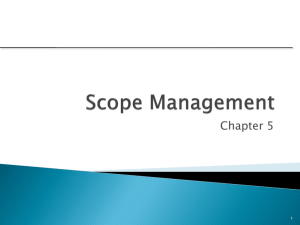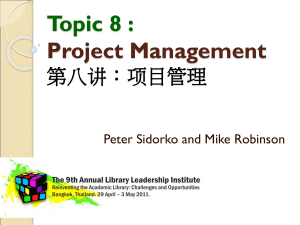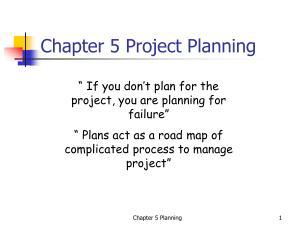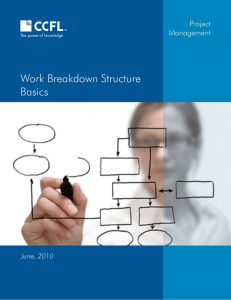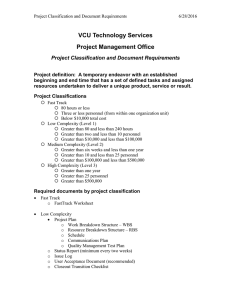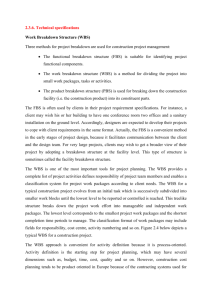SCOPE MANAGEMENT
advertisement
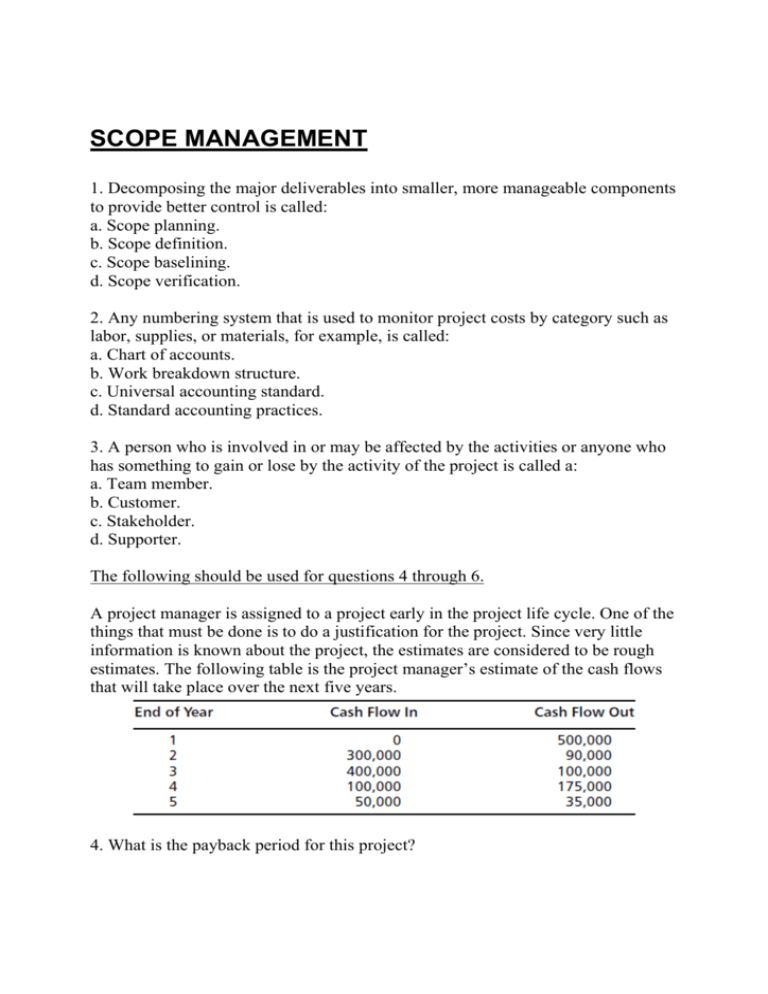
SCOPE MANAGEMENT 1. Decomposing the major deliverables into smaller, more manageable components to provide better control is called: a. Scope planning. b. Scope definition. c. Scope baselining. d. Scope verification. 2. Any numbering system that is used to monitor project costs by category such as labor, supplies, or materials, for example, is called: a. Chart of accounts. b. Work breakdown structure. c. Universal accounting standard. d. Standard accounting practices. 3. A person who is involved in or may be affected by the activities or anyone who has something to gain or lose by the activity of the project is called a: a. Team member. b. Customer. c. Stakeholder. d. Supporter. The following should be used for questions 4 through 6. A project manager is assigned to a project early in the project life cycle. One of the things that must be done is to do a justification for the project. Since very little information is known about the project, the estimates are considered to be rough estimates. The following table is the project manager’s estimate of the cash flows that will take place over the next five years. 4. What is the payback period for this project? a. One year b. Two years c. Three years d. Four years 5. What is the net cash flow at the end of five years? a. $50,000 b. _$50,000 c. $850,000 d. $100,000 6. If the net present value for each of the cash flows were calculated at a 10% interest rate, the net present value cash flow at the end of five years would be: a. Greater than the total cash flow without the net present value applied. b. Less than the total cash flow without the net present value applied. c. The same as the total cash flow without the net present value applied. d. Unable to be calculated with the information supplied. 7. A group of related projects that are managed in a coordinated way that usually include an element of ongoing activity is called a: a. Major project. b. Project office. c. Program. d. Group of projects. 8. During the full life cycle of the project, a plot of the project’s expected expenditures will usually follow a characteristic ‘‘S’’ shape. This indicates that: a. There is a cyclic nature to all projects. b. Problems will always occur in the execution phase. c. There are high expenditures during closeout. d. The bulk of the project budget will be spent in the execution phase. 9. A temporary endeavor undertaken to create a new product or service is called a: a. New product development. b. Project. c. Program. d. Enterprise. 10. A project manager makes a narrative description of the work that must be done for her project. This is called a: a. Project plan. b. Control chart. c. Statement of work. d. Project objective. 11. An example of scope verification is: a. Reviewing the performance of an installed software module. b. Managing changes to the project schedule. c. Decomposing the WBS to a work package level. d. Performing a benefit-cost analysis to determine if we should proceed. 12. The process of establishing clear and achievable objectives, measuring their achievement, and adjusting performance in accordance with the results of the measurement is called: a. Strategic planning. b. Contingency planning. c. Detailed planning. d. Management by objectives. 13. Configuration management is: a. Used to ensure that the description of the project product is correct and complete. b. The creation of the work breakdown structure. c. The set of procedures developed to ensure that project design criteria are met. d. A mechanism to track budget and schedule variances. 14. A project manager is employed by a construction company and is responsible for the furnishing of the completed building. One of the first things that the project manager for this project should do is to write a: a. Work breakdown structure. b. Budget baseline. c. Project charter. d. Project plan. 15. A project manager is creating a work breakdown structure for her project. In the breakdown structure the lowest level of the breakdown for the project manager is called the: a. Activity. b. Task. c. Work package. d. Cost account. 16. A project manager is reviewing the scope of the project and the scope baseline of the project. This includes which of the following? a. The original project schedule, budget, and scope b. The original project description and the project charter c. The original scope of the project plus or minus any scope changes d. The current budget of the project 17. A project manager has just become the manager of a project. The document that recognizes the existence of the project is called: a. The statement of work. b. The project assignment. c. The project charter. d. The product description. 18. A project manager is reviewing the work breakdown structure for her project. The WBS for the project represents: a. All the tangible items that must be delivered to the client. b. All the work that must be completed for the project. c. The work that must be performed by the project team. d. All the activities of the project. 19. A manager who manages a group of related projects is called a: a. Project manager. b. Project expediter. c. Program coordinator. d. Program manager. 20. A new project has begun. The project charter has been written and the project manager has been assigned. The project manager is preparing the work breakdown structure for the project. The WBS is typically used for: a. Explaining the scope of the project relevant to the client. b. The basis for organizing and defining the total scope of the project. c. Showing the resource conflicts that exist in the project. d. The logical relationship between tasks in the project. 21. During the life of a project, the project will go through several phases— initiating, planning, execution, and closeout. Which phase of the project is likely to have the greatest amount of its funding spent? a. Initiating b. Planning c. Executing d. Closeout 22. During the course of the project it is important that the stakeholders be informed of the progress of the project. One of the reports that is frequently used is a progress report. Which of the following is true about progress reports? a. They allow stakeholders to judge the performance of the project according to its plan. b. They are generally considered to be overkill on very small projects. c. They require the use of earned value reports. d. They must be produced by the project manager. 23. The coordinated undertaking of interrelated activities directed toward a specific goal that has a finite period of performance is a: a. Project charter. b. Project. c. Set of project objectives. d. Program. 24. The document that is proof of upper management’s commitment to the project and gives the authority to manage the project to the project manager is called: a. The project plan. b. The project goals and objectives. c. The project charter. d. The project definition. 25. A project manager works in a company favoring the weakest authority for the project manager. The type of organization that holds the project manager to be the weakest is: a. Projectized organization. b. Strong matrix organization. c. Weak matrix organization. d. Balanced matrix organization. 26. A project manager has been asked by the client to meet the promise date of the project. The project manager analyzes the schedule before promising a date to the customer. The project manager uses the program evaluation and review technique to evaluate the project schedule. She decides that based on the results of the PERT calculations she can promise a delivery date of June 30. The expected value of the project completion date is May 30. If the project manager is willing to accept a 5% probability that the project will be delivered later than June 30, what is the standard deviation of the durations of the activities on the critical path? Assume a five-day workweek. a. Ten days b. Fifteen days c. One-half month d. One month 27. A project is proposed to a customer. Price and schedule for delivery are agreed upon. The work breakdown structure is agreed to as well. The customer requests that one of the milestones of the project be completed by a certain date. The project schedule is reviewed, and it is found that the expected completion date for this milestone is considerably earlier than the date requested by the customer. The date for this milestone is which of the following? a. Consideration b. Summary activity c. Constraint d. Suggestion 28. A project manager is managing a project. The original scope baseline of the project was budgeted at $100,000. Since work on the project started there have been seventeen authorized and approved changes to the project. The changes have a value of $17,000 and the cost of investigating them prior to their approval was $2,500. What is the current budget for the project? a. $100,000 b. $114,500 c. $117,000 d. $119,500 29. In a very large project having a budget of $5 million and a project team of over one hundred persons, the project manager constructs a work breakdown structure. The project manager will do the WBS to the detail level of which of the following? a. Task b. Activity c. WBS element d. Work package 30. A project manager is managing a project that has reached the end of the planning phase. The work scope has been agreed to and definitive cost estimates have been completed for the project. The total estimated cost of the project is $100,000. It is reasonable to expect that the project will not cost over which of the following values? a. $100,000 b. $110,000 c. $125,000 d. $175,000 31. The change management plan should be included in which of the following? a. Scope management plan b. Communications management plan c. Configuration management plan d. Quality management plan 32. A project team has made up the work breakdown structure for a project. Senior management for the company and all of the stakeholders including the client have approved the WBS. The client later requests that a change be made in the project, which will cost a considerable amount of money. The client says that the company’s salesman promised this feature prior to sign-off on the WBS. Who should pay for the change? a. The client should pay. b. The company managing the project should pay. c. Both the company and the client should pay part of the cost. d. The change should not be implemented. 33. A project manager is managing a software development project for a hospital. There is a new computer available that will speed up the development process considerably. The new computer costs $50,000 including shipping, installation, and start-up. The computer will cause a gross savings of $100,000. What is the net present value of the savings if they occur one year after the expenditure for the computer? Assume a 10% interest rate. a. $90,000 b. $40,909 c. $45,555 d. $91,110 34. A project manager is managing a project during the planning phase. She chooses to use a precedence network diagram as a graphic planning tool to assist in making the project schedule. The most important reason for using the network diagram as a graphic planning tool is that it makes it easier to see which aspect of the project plan better than the other tools available? a. The probability that the tasks will be completed on time b. The logical relationships between activities in the schedule c. The start and finish dates of the activities d. The float between activities



